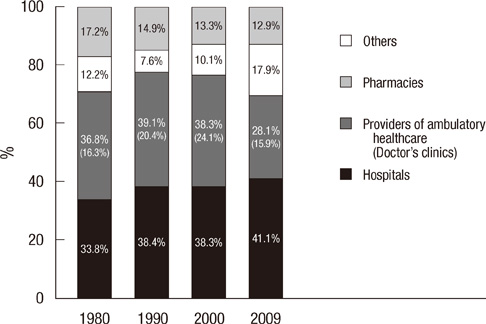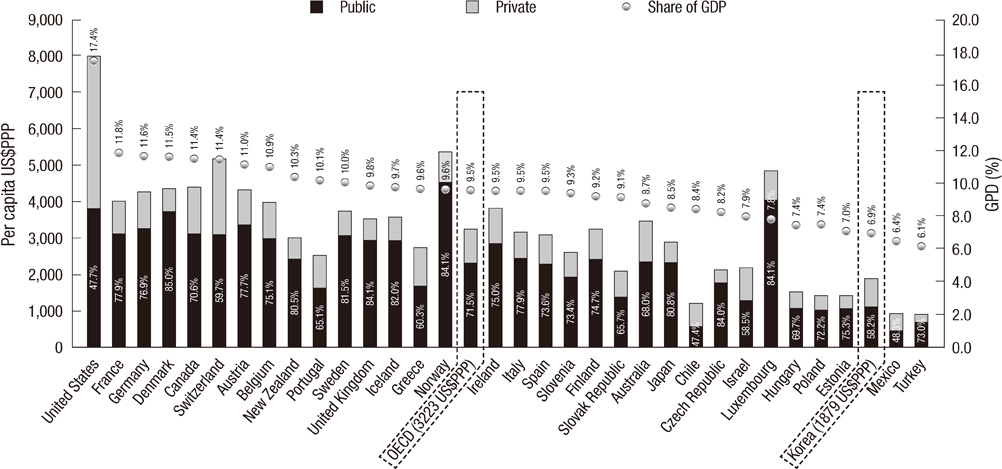J Korean Med Sci.
2012 May;27(Suppl):S13-S20. 10.3346/jkms.2012.27.S.S13.
Trends in Scale and Structure of Korea's Health Expenditure over Last Three Decades (1980-2009): Financing, Functions and Providers
- Affiliations
-
- 1Department of Health Administration, College of Health Science, Yonsei University, Wonju, Korea. jeonghs@yonsei.kr
- 2Yonsei Institute for Health and Welfare, Wonju, Korea.
- KMID: 1714483
- DOI: http://doi.org/10.3346/jkms.2012.27.S.S13
Abstract
- This paper introduces statistics related to the size and composition of Korea's total health expenditure. The figures produced were tailored to the OECD's system of health accounts. Korea's total health expenditure in 2009 was estimated at 73.7 trillion won (US$ 57.7 billion). The annual per capita health expenditure was equivalent to US$ PPP 1,879. Korea's total health expenditure as a share of gross domestic product was 6.9% in 2009, far below the OECD average of 9.5%. Korea's public financing share of total health expenditure increased rapidly from less than 50% before 2000 to 58.2% in 2009. However, despite this growth, Korea's share remained the fourth lowest among OECD countries that had an average public share of 71.5%. Inpatient, outpatient, and pharmaceutical care accounted for 32.1%, 33.0%, and 23.7% of current health expenditure in 2009, respectively. A total of 41.1% of current health expenditure went to hospitals, 28.1% to providers of ambulatory healthcare (15.9% on doctor's clinics), and 17.9% to pharmacies. More investment in the translation of national health account data into policy-relevant information is suggested for future progress.
Keyword
MeSH Terms
Figure
Cited by 1 articles
-
Ubiquitous Health in Korea: Progress, Barriers, and Prospects
Yountae Lee, Hyejung Chang
Healthc Inform Res. 2012;18(4):242-251. doi: 10.4258/hir.2012.18.4.242.
Reference
-
1. OECD. A system of health accounts. 2000. Paris: Organisation for Economic Co-operation and Development.2. Kwon SW. A study on national health expenditure: estimation and analysis. 1986. Chuncheon: Hallym Institute of Social Sciences.3. Park CK, Noh IC. Estimation of Korea's national health expenditure: 1970-1974. 1976. Seoul: Korea Development Institute.4. Jang YS, Doh SR, Gho KH, Lee RY. Estimation of national health expenditure in Korea. 2000. Seoul: Korea Institute for Health and Social Affairs.5. Jung YH. National health expenditures of Korea: 1985-1998. Korean Soc Secur Stud. 2001. 17:1–33.6. Jung YH, Lee KJ, Kang SW. Korea's national health expenditure account. 2000. Seoul: Korea Institute for Health and Social Affairs.7. Myoung JI, Hong SJ. A structure and trends of national health expenditure: 1985-1991. 1994. Seoul: Korea Institute of Health Services Management.8. Shin CG. National health expenditure category of healthcare providers in Korea. Korean Soc Secur Stud. 1998. 14:63–95.9. Jeong HS, Lee JH. Construction of time-series data for health accounts by function, finances and providers. 2005. Seoul: Ministry of Health and Welfare.10. Jeong HS. Korean national health accounts and total health expenditure in 2009. 2011. Seoul: Ministry of Health and Welfare.11. Shin JW, Jeong HS. Factors influencing household expenditure on healthcare. Korean J Health Econ Policy. 2007. 13:97–117.12. OECD. A system of health accounts 2011. 2011. Paris: Organisation for Economic Co-operation and Development.13. Kim WS. Division of role between physician and pharmacist on drug and development of national health insurance: the ten years of love and hatred. Korean Soc Secur Stud. 2010. 26:159–193.14. Kwon SM. Fiscal crisis of the national health insurance in Korea: Causes and Policy Options. Korean Policy Stud Rev. 2001. 10:177–198.15. Jeong HS. Pharmaceutical reforms: implications through comparisons of Korea and Japan. Health Policy. 2009. 93:165–171.16. Jeong HS. Healthcare reform and change in public-private mix of financing: a Korean case. Health Policy. 2005. 74:133–145.17. Jeong HS. Pharmaceutical impact of the reform for separation between prescribing and dispensing of drugs upon financial situation of the national health insurance. Korean J Health Policy Adm. 2006. 16:117–134.18. Lee KS. Achievement of health promotion program in Korea. Korean J Health Educ Promot. 2006. 23:143–171.19. OECD. Health at a glance 2009. 2009. Paris: Organisation for Economic Cooperation and Development.20. Orosz E, Morgan D. SHA-based national health accounts in thirteen OECD countries: a comparative analysis. 2004. Paris: Organisation for Economic Co-operation and Development.21. OECD. OECD StatExtracts. accessed on 31 August 2011. Available at http://stats.oecd.org/index.aspx.
- Full Text Links
- Actions
-
Cited
- CITED
-
- Close
- Share
- Similar articles
-
- Patterns of Health Expenditures and Financial Protections in Vietnam 1992-2012
- 1970-2014 Current Health Expenditures and National Health Accounts in Korea: Application of SHA2011
- 2015 National Health Accounts and Current Health Expenditures in Korea
- 2018 Current Health Expenditures and National Health Accounts in Korea
- Catastrophic Health Expenditure Status and Trend of Korea in 2015





